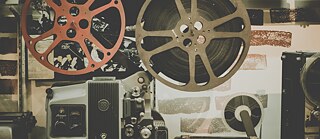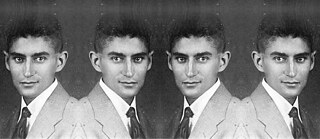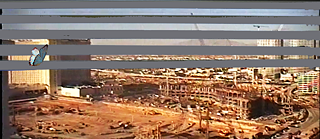Early pop culture Kafka, the Cinephile

At the beginning of the 20th century, cinema was new and sensational – Franz Kafka was fascinated by it. There are numerous mentions of what Kafka had seen at the movies.
Prague-born Franz Kafka (1883–1924) experienced the emergence of the cinematograph and was fascinated by the very first early films. From today’s perspective, this was “primitive cinema”, often of a tabloid nature. Nevertheless, it literally captivated Kafka, as he mentions in his diaries and his letters written to his fiancée Felice Bauer. His comments on the films are written in an “excited, passionate” and at times “melancholic tone”, according to the German actor and writer Hanns Zischler.Cinema as distraction and attraction
Kafka became an active filmgoer as early as the 1910s. Film, which was still in its infancy, was not yet considered art, and many writers refused to collaborate with filmmakers on scripts. They did not believe in quality adaptations of their works and chose not to support film, which they saw as a “fairground attraction” (unlike theatre). The situation only changed in the 1920s, when feature films began, slowly but surely, to be considered as art and not just light entertainment.The first permanent cinema to be established in Prague was U modré štiky (Blue Pike) in Karlova Street. From 1907 it was managed by the illusionist Viktor Ponrepo, who used film screenings to enhance his theatrical performances and who also accompanied silent films with brilliant commentary. The advertising leaflets promised “scenes from life and the world of dreams” that were capable of nothing less than “satisfying all the spectators’ needs”. Kafka was a regular here, as he was at the Orient cinema, which operated from 1908 in Prague’s Hybernská Street. Just a year later, another cinema, the elegant Lucerna, which also housed a cabaret and a café, opened its doors to the people of Prague. It is still in operation today (featuring, for instance, the German-language film festival Das Filmfest on a regular basis) and Kafka used to go there alone, with his family or with friends. Among those closest to Kafka was the writer Max Brod, who often recalled how he and Kafka visited cinemas not only in Prague, but also during their travels in Italy, France and Germany.
“White Slave Trade” and other blockbusters
Danish director August Blom’s White Slave Trade (Den hvide slavehandel I, 1911) was relatively long, unlike his first shorts: it had a remarkable 55 minutes, making it the first ever medium-length feature film in the history of cinema. It was received with a lot of interest by audiences. Although this interest was not always positive – the film revolved around a brothel, sparking discussions about whether it ought to be considered kitsch and banned for, among other reasons, the sexuality it depicted, or whether it could be seen as a daring piece of cinema –, the movie was nevertheless talked about everywhere. The Czech writer Jiří Mahen wrote a review of the film in Lidové noviny in 1911 arguing that: “(…) Anyone who has a conscience in his breast and reason in his head just about has to vomit. It is a perfectly ordinary cinematographic stupidity, nothing more.” Despite its pulp plot, this action-packed story absorbed Kafka through its emotions, exotic location and its many car chases and shootouts on rooftops in its finale. Kafka was fascinated by its treatment of the fate of the beautiful Edith, who went to London to visit a relative, but fell into the hands of bandits on the ship and ended up in a brothel, where two men fell in love with her: but it took the right one, an engineer from a steamship, to rescue her with the help of the police. Kafka dreamed passionate and terrifying dreams about both the innocent Edith and the sadistic female slaver who abused her.Kafka also liked other silent films from that period. Primarily these were early documentaries depicting the Czech city of a hundred spires, Prague. Worth mentioning here is the charming two-minute Journey through Prague in an Open Tram (Jízda Prahou otevřenou tramvají, 1908), directed by Jan Kříženecký, a cameraman, photographer and pioneer of Czech cinema. Using the camera originally placed in the front of trams (serving the 3 and 7 lines), we watch footage showing the atmosphere of a now vanished Prague (its embankment, bridges, Letná, the view of Prague Castle and the Jewish Town – in Kafka’s immediate neighbourhood – as it was being cleared away during the asanation).
Kafka was also enthralled by the Italian documentary The First International World Airplane Competition in Brescia (Primo Circuito Aereo Internazionale Di Aeroplane In Brescia, 1909), directed by Adolfo Croce, a technical curiosity that captures the prestigious Grand Prize event. The film charts the preparation of the planes for take-off and their actual take-off. We see the interplay of the mechanics, feel the anticipation of 50,000 spectators and the sincere enthusiasm of the designers and filmmakers for flying machines, and celebrate Glenn Curtiss’s victory in this international air race held on 9 September 1909. Kafka, who was enjoying a holiday in north-eastern Italy at the time, was present at the event in person with Max Brod, and wrote an account of the emotional experience, The Aeroplanes at Brescia (Die Aeroplane in Brescia). His report was published in the Prague daily Bohemia: “Curtiss will fly for the grand prize of Brescia. [...] Already Curtiss’s motor is roaring, we scarcely look toward him, already he is flying away from us, flying across the plain, which grows larger in front of him, to the woods in the distance, which now seem to rise up for the first time. Long is his flight over those woods; he disappears we are looking at the woods, not him.”
However, Kafka did not only travel physically, but also through film. In this regard, let us mention the Italian films Peschiera, Lago Maggiore, Liguria, Il corse de Mirafiori (1907–1913, collectively directed), which were also shown in Prague and offered their viewers colourisation (i.e. the colouring of the shots in green, blue, yellow, sepia, brown, etc.). These documentaries from Italy had a meditative style, conveying holiday atmosphere, and the audience, including Franz Kafka, enjoyed being carried away by the waves of the sea, the beauty of lakes, caves and ancient monuments. They also included a final show of socialites and the fashion (ladies in hats) of that time at a famous horse race.
A lost painting and a search for home
What about comedy? Worthy of note is the French production Nick Winter and the Theft of the Mona Lisa (Nick Winter et le vol de la Joconde, 1911) directed by Paul Garbagni and Gérard Bourgeois, a playful ten-minute parody film involving the world’s first film producer, Charles Pathé. The story is inspired by a real event at the Louvre: the theft of the Mona Lisa on 21 August 1911 and the subsequent police investigation, which, however, came to nothing: the painting was found, more or less by chance, two years later in Italy.Interestingly, the Louvre’s attendance did not suffer after the theft of the rare painting; on the contrary, thousands of people – including Franz Kafka and Max Brod – flocked to the gallery to see the empty space on the wall.
Kafka claimed to be a convinced Zionist for a period of his life. It was a time when he was contributing to the Zionist newspaper Selbstwehr and learning Hebrew, although his knowledge of the language remained at an elementary level. Clearly, Kafka’s language was German, but he was also fluent in Czech and French. Kafka’s diaries show that he even flirted with the idea of moving to Palestine, not only because of his poor health (the climate there could improve his tuberculosis) but also because of friends, who would support him financially there. And how does this relate to film? In 1921, Kafka wrote this in his diary: “A film about Palestine in the afternoon.” We know that it was the film Return to Zion (Shivat Zion, 1921), which he saw at the Lido cinema in Havlíčkova Street. The film depicts the new life and the economic building up of Palestine, including a colourful mix of peoples and a political line that must have been included. Filmed on commission in Jerusalem, it was intended to promote and inform Jews about what the situation looked like on the ground in Palestine. To what extent Kafka was serious about his decision to leave Europe and how much this particular cinema experience influenced him, we will never know. Palestine remains for Kafka an unreachable terrain, a ground he is unable to tread, near enough to touch and far away – an imaginary space, a film.
After all, what did films actually mean to Kafka? We can also only guess. However, one thing is clear: the famous writer was fascinated by film, and he knew the weekly cinema programmes by heart. For him cinema was beauty, joy but also suffering. It is quite possible that cinemas for Kafka meant the chance to escape from his loneliness and from his own life, which seemed rather ordinary at first glance. Kafka, a trained lawyer, had been working as a clerk at the Worker's Accident Insurance Institute in Prague (which was only a few steps away from the Lucerna cinema) since 1908, but the work was not fulfilling and he was bored. He carried out his work very conscientiously, but found it terribly dull. He divided his spare time between the duties in his strict father’s shop, escapades with his growing circle of friends – cafés, cinemas, cabarets, brothels – and increasingly important literary experiments. As Hanns Zischler aptly noted: “In the course of this year he will plunge into the cinema several times, seeking and longing for meaninglessness. He goes to the movies to forget. There is probably no more fitting place to achieve this pleasurably.”


